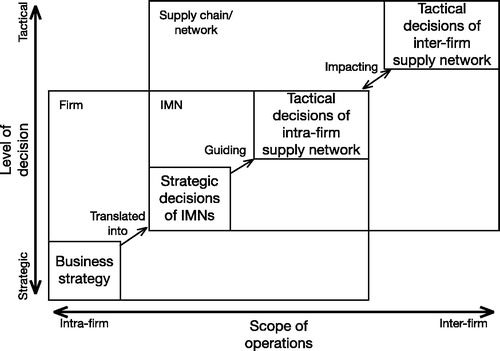Abstract
The purposes of this article are to provide a brief overview of the research on international manufacturing networks (IMNs), identify corresponding gaps and provide background for the papers published in this special issue. First, this article shows the importance of addressing the management of IMNs, especially in times of global turbulence as a result of new economic, political and technological trends. Second, it highlights research into the management of IMNs as a missing link in the Operations Management (OM) discipline, as most of the current OM research neglects the fact that the internal structures and relationships of multi-plant organizations inside firms play a critical role in how a supply chain/network operates and relies mostly on scholars in other fields for insights into high-level and strategic issues in the management of global operations. Finally, this article argues there is still a lot to do in order to develop new theories towards the total management of global networks that can holistically analyze different global (intra- and inter-firm multi-functional) networks and address the complex interdependencies between them.
1. Addressing the management of international manufacturing networks
During the past few decades, both global trade and foreign direct investment (FDI) have increased explosively. On the one hand, global trade has been growing faster than global economic output for most of the last 50 years, and the world has been producing more output and sending an increasingly larger share of it across national boundaries (Ferdows Citation2018). On the other hand, United Nations Conference on Trade and Development (UNCTAD Citation2013) reported that, in 2012, for the first time developing countries absorbed more FDI than developed countries. These all point to the increasing global spread of production. In fact, considering production is one of the single largest types of FDI in most countries (Ferdows Citation1997; Cheng, Farooq, and Johansen Citation2011), it can safely be said that the trend of global production is bound to persist, survive and grow.
In this context, it is imperative for industrial companies to disperse their plants worldwide. The role of production firms has accordingly changed from supplying domestic markets with products, via supplying international markets through export, to supplying international markets through local manufacturing (Rudberg and Olhager Citation2003). Hence, manufacturing engineering and production/operations management (P/OM) have experienced a rapid change in manufacturing system concepts, moving from a plant focus to that of international manufacturing networks (IMNs), which are generally defined as a coordinated aggregation (network) of intra-firm plants/factories located in different places (Shi and Gregory Citation1998; Cheng, Farooq, and Johansen Citation2014, Citation2015a). Accordingly, the management of IMNs has gradually become an important task for production firms, as it has a considerable impact on their future performance and profitability. Any changes as a result of management decisions can rapidly turn a well-configured network into a poor one and can put a company out of business in a matter of years.
This task has recently become more urgent due to global turbulence caused by new economic, political and technological trends. First, firms’ strategies towards the management of IMNs are being reconsidered due to shifts in global economic development, including rapidly increasing wage levels in less developed countries such as China (Demeter Citation2017), fluctuating customer demand and the development of new local competitors within emerging markets that are able to challenge foreign multinationals. Second, conservative winds and national protectionism within politics have changed the rationale behind the management of IMNs. Significant political events, such as President Donald Trump’s election and the United Kingdom’s referendum on membership in the European Union, are believed to have an extensive impact on the propensity of firms to manage their IMNs. Third, the introduction of new vibrant technologies has started to change the traditional production methods for many products with profound implications for manufacturing location and network design (Brennan et al. Citation2015). With such a variety of developments presently influencing the management of IMNs, a discussion of its future trajectories is both timely and necessary.
2. The management of international manufacturing networks: a missing link
Research on IMNs can be traced back to discussions on internationalization/globalization, especially in relation to international business (IB). It was not until the 1960s that the term ‘internationalization/globalization’ began to be widely used by social scientists (Cheng, Johansen, and Hu Citation2015). Later on, internationalization/globalization attracted much attention in the IB domain. Since the late 1990s, prestigious IB journals, such as Journal for International Business Studies (since 1996), Journal of International Marketing (1996), International Small Business Journal (2004) and Journal of International Management (1998), started to focus on the issue of internationalization (Demeter Citation2017). Nevertheless, IB mainly considers marketing, sales and Research & Development (R&D) functions as issues to be studied in the internationalization processes of firms, whereas manufacturing/operations has inexplicably received far less attention. This lack of interest makes it seem that manufacturing/operations is ancillary, basic but not strategic at firm level, and lacks relevance in explaining internationalization strategies. Accordingly, IB research rarely discusses global operations or investigates the management of IMNs although it has had a long history of studying networks and addressing network-related topics.
Nevertheless, the increasing global fragmentation of operations creates more complexity and calls for more research, particularly from Operations Management (OM) scholars, who should have a more significant voice in the discussion of firms’ cross-border operations. This line of discussion is currently the domain of researchers in ‘strategy, IB, and even economics, trade, or public policy, among others,’ but it can and should be enriched by adding a stronger operations perspective; for example, drawing attention to the less obvious or unintended operational costs (or benefits) in global supply chains and production networks that might otherwise not receive adequate scrutiny from experts in other fields (Ferdows Citation2018). However, except for a notable few, the management of global operations has not received sufficient attention from the OM research community (Ferdows Citation2018). Prasad and Babbar (Citation2000) identified that the management of global operations was addressed by relatively few papers appearing in leading OM and general management journals. Ferdows (Citation2018) observed that the same still holds true for recently published papers (2013–16) in the major OM journal outlets. Instead, the current OM research has had more discussions about the externalization of manufacturing and thus focused more on the inter-firm supply chain/network. With roots in physical distribution, materials management and outsourcing, research on supply chains/networks tends to analyze the network as external with facilities owned by different organizations and address the links between the facilities (Rudberg and Olhager Citation2003). This research is focused on relatively narrow topics and tactical issues, such as forecasting disruptive demands, optimizing production planning, managing inventories at regional or country warehouses, coping with the risks of working with international suppliers (e.g. terms of contract, information asymmetry, assessing suppliers’ delivery reliability and controlling the quality of products produced by foreign suppliers) and optimizing transportation (e.g. routing and cross-docking).
In short, research into the management of IMNs has yet to achieve wide circulation in academia. While it is understandable that IB research seldom goes into the black box of manufacturing/operations, it is inexplicable that only a small percentage of the articles in 21 leading OM journals from 1979 to 2014 focused on issues related to the management of IMNs (Cheng, Farooq, and Johansen Citation2015). Most of the current OM research focuses upon inter-firm relationships, essentially neglecting intra-firm relationships and the ways in which the internal structures and relationships of multi-plant organizations inside firms play a critical role in how supply chains/networks operate and make an impact (Dicken and Malmberg Citation2001; Coe, Dicken, and Hess Citation2008). They tend to treat IMNs as somewhat of a black box. This is problematic since there is abundance of empirical evidence that the manufacturing industry is currently transforming not only from the traditional vertically-integrated value chain to a collaboration between specialized independent companies but also from a single plant-based manufacturing system centralized or dispersed within one country towards a multi-plant system and further to, plant networks with geographic dispersion and operational integration owned by a multinational corporation (Shi and Gregory Citation2005; Cheng and Johansen Citation2014). In other words, OM implications of global operations and IMNs are important for practice but are still under-researched by OM scholars (Demeter Citation2017), highlighting the need for increased and equal attention on the management of IMNs.
It is also problematic that the OM discipline merely addresses the narrow topics and tactical issues listed above, but relies mostly on scholars in other fields for insights into high-level and strategic issues in the management of global operations. Instead, OM scholars should link firms’ business strategies with the management of global operations and IMNs and take on the significant decisions in this area, including specifying strategies for choosing global sites for production and setting their strategic roles (Ferdows Citation2018), designing the configuration of a firm’s IMN (which can be thought of as the structure of multi-plant networks and concerns issues such the building of an IMN [Colotla, Shi, and Gregory Citation2003]) and managing the coordination of the firm’s IMN (which refers to the questions of how to link or integrate manufacturing facilities and how to achieve an efficient and effective plan among the network’s plants [Rudberg and Olhager Citation2003; Cheng, Johansen, and Boer Citation2008]). The 10 papers accepted for publication in this special issue generally cover this range of decisions and are briefly introduced in the next section.
3. Selected papers in this special issue
In this special issue, three of the selected papers address plant-level analysis:
Granlund et al. highlight the concept of a lead factory by examining how the lead factory role is operationalized as well as the associated challenges.
Arellano et al. use a resource-based view to investigate how integrative capabilities of a plant embedded in a manufacturing network enhance its operational performance.
Blomqvist and Turkulainen use the case study method to elaborate on the management of international manufacturing through a combined analysis of manufacturing networks and the role of individual plants within these networks.
Three papers discuss the configuration of IMNs:
Pashaei and Olhager examine the relationships between product architectures and the structure of global operations networks, and their impact on operational performance.
Feldmann and Olhager present a taxonomy of international manufacturing networks in terms of their structure by investigating 20 product group networks at five global manufacturing firms.
Christodoulou et al. explore the network synergies available from the configuration of highly dispersed global production networks.
The final four papers consider the coordination of IMNs:
Fredriksson and Jonsson explore how knowledge properties of a manufacturing activity transfer in an international manufacturing network impact performance during the transfer itself and after a steady state has been achieved.
Demeter and Losonci investigate how lean knowledge is transferred within multinational networks and discuss the type of organizational context that supports this process.
Arndt et al. provide an integrated approach for optimizing quality control in international manufacturing networks.
Wang and Zhang reveal four ways in which engineering networks may contribute to IMNs to enhance their capabilities and improve their performance in an international context.
4. Towards the total management of global networks
In fact, the strategic decisions related to the management of IMNs specify the long-term goals for the further development of plants at different locations as well as the IMNs that these plants belong to. Furthermore, they provide the necessary guidelines for the tactical decisions listed above (e.g. demand forecasting, cross-construct production planning, inventory management, logistical structure and transportation mode), which need to be considered not only as related to the management of inter-firm supply chains/networks, but also to the intra-firm contexts of IMNs. Thus, when researchers discuss IMN issues, instead of focusing their attention solely on the strategies, decisions and capabilities of the nodes (the plants within a firm) and the IMNs, they should also consider the workflow between the plants and accordingly address the “intra-firm supply network”. Meanwhile, when researchers analyze supply network decisions, instead of merely focusing on the flow between the plants and their external suppliers, they should also consider node characteristics and should be guided by the strategic decisions related to intra-firm plants and IMNs. In other words, the discussions of IMNs and supply networks are highly interrelated, as illustrated in . It is especially important to address this interrelationship when facing newly emerging challenges and opportunities, such as increasing labour costs in the Far East, increasing transportation costs, the need for quick responsiveness and the development of suppliers in developing countries. In response to these challenges, companies have tried to restructure their supply chains/networks through, e.g. reshoring and backsourcing, driving the need for changes in the way IMNs are configured and managed. Similarly, any adjustments companies make to IMNs will have consequences for their supply chains/networks.
Figure 1. The relationship between the discussions of business strategy, IMN and supply chain/network.

Altogether, this information indicates that companies must simultaneously rethink their IMNs and their supply networks with a broad and holistic perspective; it also implies that the boundaries between manufacturing and supply networks are in a continuous state of flux, involving a complex reconfiguring of organizational boundaries and including the proliferation of various forms of intra- and inter-firm collaboration (Coe, Dicken, and Hess Citation2008). As the link between structure and capability becomes intertwined in highly-networked production and supply systems with multiple choices on ownership, location and integration, we believe that manufacturing and supply networks cannot be managed separately; we assume that when one changes, it is unlikely to happen in isolation but instead has implications for other networks.
In addition to international sourcing (as well as the corresponding externalization of manufacturing), the internationalization of manufacturing has in many cases been a starting point that is followed by the internationalization of other value chain activities (e.g. service, engineering and R&D), creating a snowball effect (Cheng and Johansen Citation2014). As a result, companies have to deal with the complexity of the geographical dispersion of manufacturing, sales, service, engineering and R&D (Cheng, Farooq, and Johansen Citation2015; Cheng, Johansen, and Hu 2015). This further means network decisions based on traditional geographical advantages or sub-optimization of the IMN might no longer provide sufficient competitiveness. Instead, companies have to address various global functional networks simultaneously.
According to these observations, new theories need to emerge for the total management of global networks that can holistically analyze different global (intra- and inter-firm multi-functional) networks and address the complex interdependencies between them. However, the existing research remains fragmented exclusively focusing on the networks of specific facilities and discussing them independently. There is currently no research on global OM that offers a comprehensive and integrated framework for managing intra/inter-firm multi-functional networks of geographically dispersed operations along the value chain. Relevant research effort can be only seen in the field of economic geography. Over time, the most productive lines of enquiry within economic geography have shifted the analytical focus towards the tightly-coordinated global chains or networks of firms engaging in cross-border value activities. This development has further stimulated the rise of a corresponding conceptual model, i.e. Global Production Networks (GPNs) (Neilson, Pritchard, and Yeung Citation2014; Yeung and Coe Citation2015). According to economic geographers, the concept of GPNs covers both intra-firm and inter-firm transactions and forms of coordination, and links together a network flagship’s own subsidiaries, affiliates and joint ventures with its subcontractors, suppliers, service providers and partners in strategic alliances (Ernst and Kim Citation2002). After years of development, GPNs are the most critical organizational platforms through which production in primary and service sectors is coordinated and organized on a global basis (Yeung and Coe Citation2015). A 2010 World Bank report claimed that “given that production processes in many industries have been fragmented and moved around on a global scale, GPNs have become the world economy’s backbone and central nervous system” (Cattaneo, Gereffi, and Staritz Citation2010). Nevertheless, the management of GPNs has, at the same time, become a more complicated topic for scholars, leading to at least three research gaps that need to be addressed. The first gap concerns the problem of moving materials, components and finished products. In contrast to the assumption of economic geographers that this problem has been solved through technological development, logistics and supply chain management have become even more critical due to the vast increase in complexity and geographical extensiveness of GPNs (Coe, Dicken, and Hess Citation2008). The second gap concerns the treatment of the firm. Virtually all of the attention in the existing literature on GPNs focuses on inter-firm relationships and neglects intra-firm relationships and the ways in which the internal structures and relationships inside firms play a critical role in how GPNs operate (Dicken and Malmberg Citation2001). Third, the existing GPN research neglects the fact that individual (plant and R&D) subsidiaries, joint ventures, strategic alliances and independent suppliers/distributors have gradually developed to be intra-firm multi-functional networks, cross-firm partner networks, and inter-firm supply networks. These networks can be viewed as the networks embedded within a GPN, which, in turn, can be thought of as a series of intricate intersections between the vertical and horizontal as well as between intra- and inter-firm networks of varying degrees of size and complexity (Coe, Dicken, and Hess Citation2008). In addressing these gaps, OM scholars should play a more significant role in the development of new theories towards the total management of global networks, where more attention should be paid to intra-firm relationships; and a multi-dimensional network perspective that considers the connections and synergies between processes of value creation in different networks needs to be adopted. Thus, it will become increasingly important to incorporate value chain activities (both intra- and inter-firm), coordinate different functions, and align them with the location of global operations in order to increase the performance of and minimize the risks to a company (Cheng, Farooq, and Johansen Citation2015; CitationCheng, Johansen, and Hu 2015). We still have a lot to do.
Acknowledgements
The guest editors of this special issue are grateful to all reviewers for their valuable contributions in reviewing the papers. We are also grateful to the journal editor, Professor Stephen Childe, and the editorial and publishing teams for their continuous support. Finally, we also thank the authors who submitted their papers for consideration in this special issue. We had many submissions of high quality. Unfortunately, the editorial team selected only the manuscripts that are more closely related to the special issue topics, due to limited publication space.
Disclosure statement
No potential conflict of interest was reported by the authors.
Additional information
Notes on contributors

Yang Cheng
Yang Cheng is an Associate Professor at the Center for Industrial Production, Department of Materials and Production, Aalborg University, Denmark. At the same time, he works as a visiting professor at the school of business administration of Jiangxi University of Finance and Economics, China. He holds a BEng in industrial engineering, an MSc in management science and engineering, and a PhD in manufacturing strategy and global operations. He has an extensive research experience in operations strategy, the servitization of manufacturing, global manufacturing/operations network, and knowledge transfer. In these fields, he has published more than 30 academic articles in journals such as International Journal of Operations and Production Management, International Journal of Production Economics, International Journal of Production Research, Production Planning and Control, and Supply Chain Management: An International Journal.

Sami Farooq
Sami Farooq is working as Associate Professor Operations and Supply Chain Management at Center for Industrial Production, Aalborg University (Denmark). The main focus of his research is in the management of international manufacturing networks, sustainable supply chain management and advanced manufacturing technologies. He has published his research in journals such as International Journal of Production Economics, International Journal of Production Research, International Journal of Operations and Production Management, Journal of Cleaner Production, Production Planning and Control, Journal of Manufacturing Technology Management and Supply Chain Management: An International Journal.

John Johansen
John Johansen is a Professor of Logistics and Production Planning and Control at the Center for Industrial Production of Aalborg University, Denmark. He holds an MSc in Engineering and a PhD in Industrial Management from Aalborg University. He has published articles and books in the areas of Production Planning and Control, Simulation, Logistics, Supply Chain Management and Strategic Production Development. He was the director of the Center for Industrial Production, Aalborg University, from 1999 to 2011.

Chris O’Brien
Chris O’Brien is Emeritus Professor at Nottingham University Business School, University of Nottingham (UK). He played an instrumental role in establishing the first overseas campus of University of Nottingham in Malaysia and later he developed the Nottingham University Business School campus in Ningbo (China). His principal research interests are in strategic sourcing, supply chain management and design, evolution of technologies and sustainable manufacturing systems. He has published extensively and has also edited various international journals in the field of Operations Management and Production Economics.
References
- Brennan, L., K. Ferdows, J. Godsell, R. Golini, R. Keegan, S. Kinkel, J. S. Srai, and M. Taylor. 2015. “Manufacturing in the World: Where Next?” International Journal of Operations & Production Management 35 (9):1253–74.
- Cattaneo, O., G. Gereffi, and C. Staritz. 2010. “Global Value Chains in a Postcrisis World: Resilience, Consolidation, and Shifting End Markets.” In Global Value Chains in a Postcrisis World: A Development Perspective, edited by Olivier Cattaneo, Gary Gereffi, and Cornelia Starit, Chapter 1, 3–20. Washington, DC: The World Bank.
- Cheng, Y., and J. Johansen. 2014. “Operations Network Development: Internationalisation and Externalisation of Value Chain Activities.” Production Planning & Control 25 (16):1351–69.
- Cheng, Y., J. Johansen, and H. Boer. 2008. “Coordinating Knowledge Transfer within Manufacturing Networks.” In Proceedings of the 9th International CINet Conference–Radical Challenges in Innovation Management, 5–9.
- Cheng, Y., S. Farooq, and J. Johansen. 2011. “Manufacturing Network Evolution: A Manufacturing Plant Perspective.” International Journal of Operations & Production Management 31 (12):1311–31.
- Cheng, Y., S. Farooq, and J. Johansen. 2014. “Global Operations: A Review and Outlook.” In International operations networks., edited by J. Johansen, S. Farooq, and Y. Cheng, 161–179. London: Springer.
- Cheng, Y., S. Farooq, and J. Johansen. 2015. “International Manufacturing Network: Past, Present, and Future.” International Journal of Operations & Production Management 35 (3):392–429.
- Cheng, Y., J. Johansen, and H. Hu. 2015. “Exploring the Interaction between R&D and Production in Their Globalisation.” International Journal of Operations & Production Management 35 (5):782–816.
- Coe, N. M., P. Dicken, and M. Hess. 2008. “Global Production Networks: Realizing the Potential.” Journal of Economic Geography 8 (3):271–95.
- Colotla, I., Y. Shi, and M. J. Gregory. 2003. “Operation and Performance of International Manufacturing Networks.” International Journal of Operations & Production Management 23 (10):1184–206.
- Demeter, K. 2017. “Research in Global Operations Management: Some Highlights and Potential Future Trends.” Journal of Manufacturing Technology Management 28 (3):324–33.
- Dicken, P., and A. Malmberg. 2001. “Firms in Territories: A Relational Perspective.” Economic Geography 77 (4):345–63.
- Ernst, D., and L. Kim. 2002. “Global Production Networks, Knowledge Diffusion, and Local Capability Formation.” Research Policy 31 (8–9):1417–29.
- Ferdows, K. 1997. “Made in the World: The Global Spread of Production.” Production and Operations Management 6 (2):102–9.
- Ferdows, K. 2018. “Keeping up with Growing Complexity of Managing Global Operations.” International Journal of Operations & Production Management 38 (2):390–402.
- Neilson, J., B. Pritchard, and H. W. C. Yeung. 2014. “Global Value Chains and Global Production Networks in the Changing International Political Economy: An Introduction.” Review of International Political Economy 21 (1):1–8.
- Prasad, S., and S. Babbar. 2000. “International Operations Management Research.” Journal of Operations Management 18 (2):209–47.
- Rudberg, M., and J. Olhager. 2003. “Manufacturing Networks and Supply Chains: An Operations Strategy Perspective.” Omega 31 (1):29–39.
- Shi, Y., and M. Gregory. 1998. “International Manufacturing Networks—to Develop Global Competitive Capabilities.” Journal of Operations Management 16 (2–3):195–214.
- Shi, Y., and M. Gregory. 2005. “Emergence of Global Manufacturing Virtual Networks and Establishment of New Manufacturing Infrastructure for Faster Innovation and Firm Growth.” Production Planning & Control 16 (6):621–31.
- UNCTAD 2013. “United Nations Conference on Trade and Development, Global Value Chains: Investment and Trade for Development.” World Investment Report. Geneva: Switzerland.
- Yeung, H. W. C., and N. Coe. 2015. “Toward a Dynamic Theory of Global Production Networks.” Economic Geography 91 (1):29–58.
